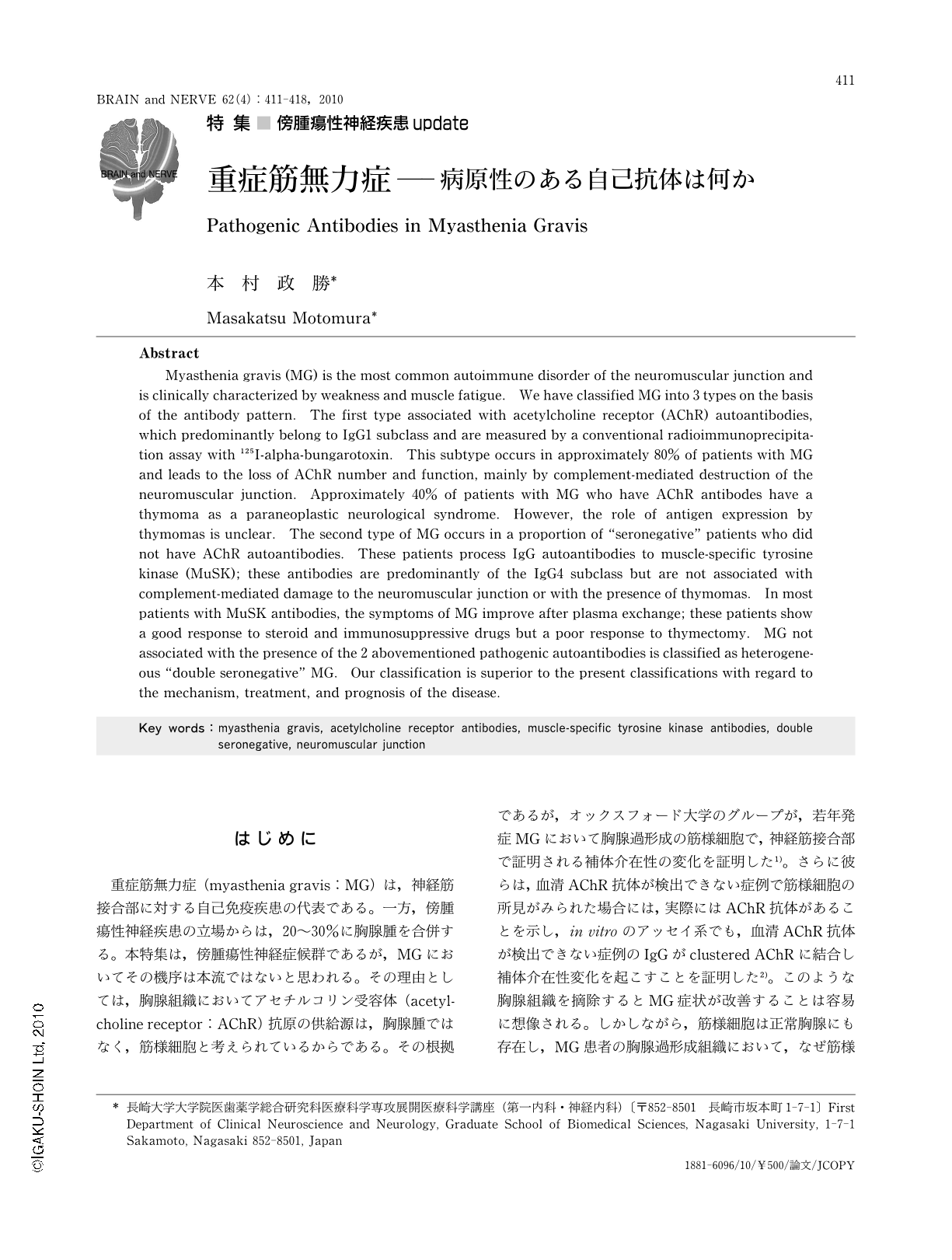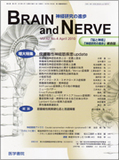Japanese
English
- 有料閲覧
- Abstract 文献概要
- 1ページ目 Look Inside
- 参考文献 Reference
はじめに
重症筋無力症(myasthenia gravis:MG)は,神経筋接合部に対する自己免疫疾患の代表である。一方,傍腫瘍性神経疾患の立場からは,20~30%に胸腺腫を合併する。本特集は,傍腫瘍性神経症候群であるが,MGにおいてその機序は本流ではないと思われる。その理由としては,胸腺組織においてアセチルコリン受容体(acetylcholine receptor:AChR)抗原の供給源は,胸腺腫ではなく,筋様細胞と考えられているからである。その根拠であるが,オックスフォード大学のグループが,若年発症MGにおいて胸腺過形成の筋様細胞で,神経筋接合部で証明される補体介在性の変化を証明した1)。さらに彼らは,血清AChR抗体が検出できない症例で筋様細胞の所見がみられた場合には,実際にはAChR抗体があることを示し,in vitroのアッセイ系でも,血清AChR抗体が検出できない症例のIgGがclustered AChRに結合し補体介在性変化を起こすことを証明した2)。このような胸腺組織を摘除するとMG症状が改善することは容易に想像される。しかしながら,筋様細胞は正常胸腺にも存在し,MG患者の胸腺過形成組織において,なぜ筋様細胞が抗原呈示細胞と作用し胚中心が形成されることによりAChR抗体が産生されるかはいまだ不明のままである。いずれにせよ,胸腺腫がAChR抗原の供給源になる可能性は低く,傍腫瘍性機序は考えにくい。本稿では,当初の目的とは外れるが,MGの主役である自己抗体に焦点をあて,その病態と臨床を中心に解説する。
Abstract
Myasthenia gravis (MG) is the most common autoimmune disorder of the neuromuscular junction and is clinically characterized by weakness and muscle fatigue. We have classified MG into 3 types on the basis of the antibody pattern. The first type associated with acetylcholine receptor (AChR) autoantibodies,which predominantly belong to IgG1 subclass and are measured by a conventional radioimmunoprecipitation assay with 125I-alpha-bungarotoxin. This subtype occurs in approximately 80% of patients with MG and leads to the loss of AChR number and function,mainly by complement-mediated destruction of the neuromuscular junction. Approximately 40% of patients with MG who have AChR antibodes have a thymoma as a paraneoplastic neurological syndrome. However,the role of antigen expression by thymomas is unclear. The second type of MG occurs in a proportion of "seronegative" patients who did not have AChR autoantibodies. These patients process IgG autoantibodies to muscle-specific tyrosine kinase (MuSK); these antibodies are predominantly of the IgG4 subclass but are not associated with complement-mediated damage to the neuromuscular junction or with the presence of thymomas. In most patients with MuSK antibodies,the symptoms of MG improve after plasma exchange; these patients show a good response to steroid and immunosuppressive drugs but a poor response to thymectomy. MG not associated with the presence of the 2 abovementioned pathogenic autoantibodies is classified as heterogeneous "double seronegative" MG. Our classification is superior to the present classifications with regard to the mechanism,treatment,and prognosis of the disease.

Copyright © 2010, Igaku-Shoin Ltd. All rights reserved.


